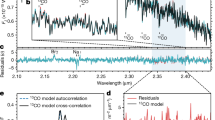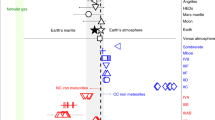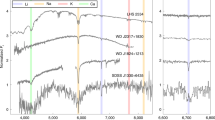Abstract
The discovery in primitive components of meteorites1,2 of large oxygen isotopic variations that could not be attributed to mass-dependent fractionation effects has raised a fundamental question: what is the composition of the protosolar gas from which the host grains formed? This composition is probably preserved in the outer layers of the Sun, but the resolution of astronomical spectroscopic measurements is still too poor to be useful for comparison with planetary material3,4. Here we report a precise determination of the oxygen isotopic composition of the solar wind from particles implanted in the outer hundreds of nanometres of metallic grains in the lunar regolith. These layers of the grains are enriched in 16O by >20 ± 4‰ relative to the Earth, Mars and bulk meteorites, which implies the existence in the solar accretion disk of reactions—as yet unknown—that were able to change the 17O/16O and 18O/16O ratios in a way that was not dependent strictly on the mass of the isotope. Photochemical self-shielding of the CO gas irradiated by ultraviolet light5,6,7 may be one of these key processes, because it depends on the abundance of the isotopes, rather than their masses.
This is a preview of subscription content, access via your institution
Access options
Subscribe to this journal
Receive 51 print issues and online access
$199.00 per year
only $3.90 per issue
Buy this article
- Purchase on Springer Link
- Instant access to full article PDF
Prices may be subject to local taxes which are calculated during checkout



Similar content being viewed by others
References
Clayton, R. N., Grossman, L. & Mayeda, T. A component of primitive nuclear composition in carbonaceous meteorites. Science 182, 485–488 (1973)
Clayton, R. N. Oxygen isotopes in meteorites. Annu. Rev. Earth Planet. Sci. 21, 115–149 (1993)
Wiens, R. C., Huss, G. R. & Burnett, D. S. The solar oxygen-isotopic composition: predictions and implications for solar nebula processes. Meteorit. Planet. Sci. 34, 99–107 (1999)
Wiens, R. C., Bochsler, P., Burnett, D. S. & Wimmer-Schweingruber, R. F. Solar and solar-wind isotopic compositions. Earth Planet. Sci. Lett. 222, 697–712 (2004)
Clayton, R. N. Self-shielding in the solar nebula. Nature 415, 860–861 (2002)
Lyons, J. R. & Young, E. D. Evolution of oxygen isotopes in the solar nebula. Lunar Planet. Sci. [CD-ROM] XXXV, 1970 (2004)
Yurimoto, H. & Kuramoto, K. Molecular cloud origin for the oxygen isotope heterogeneity in the solar system. Science 305, 1763–1766 (2004)
Chaussidon, M. & Robert, F. Lithium nucleosynthesis in the Sun inferred from the solar wind 7Li/6Li ratio. Nature 402, 270–274 (1999)
Hashizume, K., Chaussidon, M., Marty, B. & Robert, F. Solar wind record on the Moon: Deciphering presolar from planetary nitrogen. Science 290, 1142–1145 (2000)
Hashizume, K., Chaussidon, M., Marty, B. & Terada, K. Protosolar carbon isotopic composition: implications for the origin of meteoritic organics. Astrophys. J. 600, 480–484 (2004)
Morris, R. V. Origins and size distribution of metallic iron particles in the lunar regolith. Proc. 11th Lunar Planet. Sci. Conf, 1697–1712 (1980)
Epstein, S. & Taylor, H. P. Jr The isotopic composition and concentration of water, hydrogen and carbon in some Apollo 15 and 16 soils and in the Apollo 17 orange soil. Proc. 4th Lunar Sci. Conf. 1559–1575 (1973)
Taylor, H. P. Jr & Epstein, S. O18/O16 and Si30/Si28 studies of some Apollo 15, 16, and 17 samples. Proc. 4th Lunar Sci. Conf. 1657–1679 (1973)
Wiechert, U. et al. Oxygen isotopes and the Moon forming giant impact. Science 294, 345–348 (2001)
Robert, F., Rejou-Michel, A. & Javoy, M. Oxygen isotope homogeneity of the Earth: new evidence. Earth Planet. Sci. Lett. 108, 1–9 (1992)
Clayton, R. N., Mayeda, T. K. & Hurd, J. M. Loss of oxygen, silicon, sulfur and potassium from the lunar regolith. Proc. 5th Lunar Sci.Conf. 1801–1809 (1974)
Ziegler, J. F., Biersack, J. P. & Littmark, U. The Stopping and Ranges of Ions in Matter Vol. 1 (Pergamon, New York, 1985)
Wimmer-Schweingruber, R. F. in Solar Wind Ten (eds Velli, M., Bruno, R. & Malara, F.) 577–582 (AIP Press, New York, 2003)
Ireland, T. R., Holden, P., Norman, M. & Clarke, J. Oxygen isotopes in lunar metal grains — A natural GENESIS experiment. Lunar Planet. Sci. [CD-ROM] XXXV, 1448 (2004)
Hashizume, K., Marty, B. & Wieler, R. Analyses of nitrogen and argon in single lunar grains: towards a quantification of the asteroidal contribution to planetary surfaces. Earth Planet. Sci. Lett. 202, 201–216 (2002)
Wieler, R. The solar noble gas record in lunar samples and meteorites. Space Sci. Rev. 85, 303–314 (1998)
Young, E. D. & Russell, S. S. Oxygen reservoirs in the early solar nebula inferred from an Allende CAI. Science 282, 452–455 (1998)
Krot, A. N., McKeegan, K. D., Leshin, L. A., MacPherson, G. J. & Scott, E. R. D. Existence of an 16O rich gaseous reservoir in the solar nebula. Science 295, 1051–1054 (2002)
McKeegan, K. D., Leshin, L. A., Russel, S. S. & MacPherson, G. J. Oxygen isotopic abundances in calcium-aluminum-rich inclusions from ordinary chondrites: implications for nebular heterogeneity. Science 280, 414–418 (1998)
Ireland, T. R., Zinner, E., Fahey, A. J. & Esat, T. M. Evidence for distillation in the formation of HAL and related hibonite inclusions. Geochim. Cosmochim. Acta 56, 2503–2520 (1992)
Kobayashi, S., Imai, H. & Yurimoto, H. New extreme 16O-rich reservoir in the early solar system. Geochem. J. 37, 663–669 (2003)
Thiemens, M. H. & Heidenreich, J. E. The mass independent fractionation of oxygen: a novel isotope effect and its possible cosmochemical implications. Science 219, 1073–1075 (1983)
Thiemens, M. H. Mass-independent isotope effects in planetary atmospheres and the early solar system. Science 283, 341–345 (1999)
Messenger, S., Keller, L. P., Stadermann, F. J., Walker, R. M. & Zinner, E. Samples of stars beyond the solar system: Silicate grains in interplanetary dust. Science 300, 105–108 (2003)
Nagashima, K., Krot, A. N. & Yurimoto, H. Stardust silicates from primitive meteorites. Nature 428, 921–924 (2004)
Acknowledgements
Samples were provided by NASA. We thank J. Aléon, G. Libourel, B. Marty, A. Pack, F. Robert and Z. Sharp for discussions, B. Marty for encouragement, and K. Terada for help in sample preparation. This study was supported by the Mitsubishi Foundation, JSPS, MEXT, Région Lorraine, CNES-CSEEM and by INSU-PNP through a ‘Poste Rouge’ fellowship (K.H.).
Author information
Authors and Affiliations
Corresponding author
Ethics declarations
Competing interests
The authors declare that they have no competing financial interests.
Supplementary information
Supplementary Table S1
Depth profiles of Oxygen isotopic composition in metallic lunar grains. (XLS 59 kb)
Supplementary Figure S1a
Example of oxygen isotope depth profiles, plotted for grain 04-21 from lunar soil 79035, in which any negative Δ17O signatures were not observed. (DOC 60 kb)
Supplementary Figure S1b
Example of oxygen isotope depth profiles, plotted for grain 04-32 from lunar soil 79035, in which any negative Δ17O signatures were not observed. (DOC 59 kb)
Supplementary Figure S2
Oxygen isotopic composition at surfaces of seven metallic grains from lunar soil 79035, which did not show significant negative Δ17O (that is, solar) signatures. (DOC 81 kb)
Rights and permissions
About this article
Cite this article
Hashizume, K., Chaussidon, M. A non-terrestrial 16O-rich isotopic composition for the protosolar nebula. Nature 434, 619–622 (2005). https://doi.org/10.1038/nature03432
Received:
Accepted:
Issue Date:
DOI: https://doi.org/10.1038/nature03432
This article is cited by
-
The Exosphere as a Boundary: Origin and Evolution of Airless Bodies in the Inner Solar System and Beyond Including Planets with Silicate Atmospheres
Space Science Reviews (2022)
-
Concepts of the Small Body Sample Return Missions - the 1st 10 Million Year Evolution of the Solar System
Space Science Reviews (2020)
-
Constraining the Evolutionary History of the Moon and the Inner Solar System: A Case for New Returned Lunar Samples
Space Science Reviews (2019)
-
Biogenic oxygen from Earth transported to the Moon by a wind of magnetospheric ions
Nature Astronomy (2017)
-
Primordial light oxygen pockets
Nature Geoscience (2017)
Comments
By submitting a comment you agree to abide by our Terms and Community Guidelines. If you find something abusive or that does not comply with our terms or guidelines please flag it as inappropriate.



